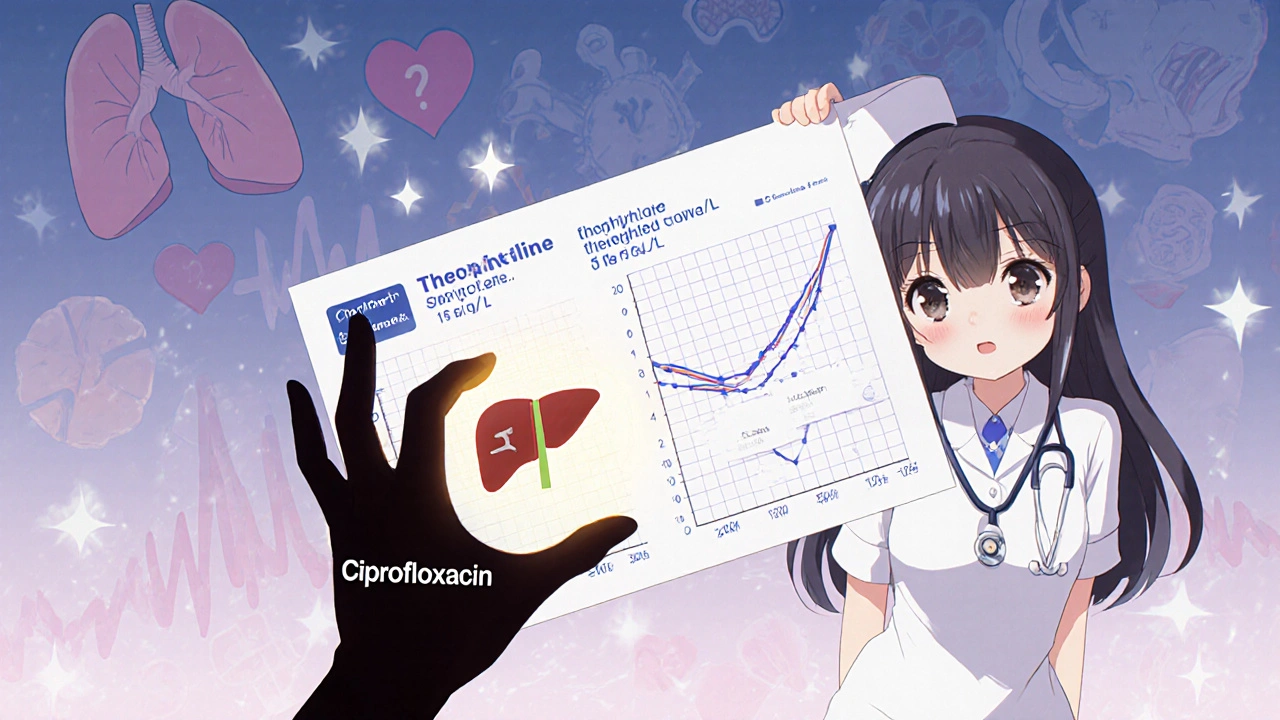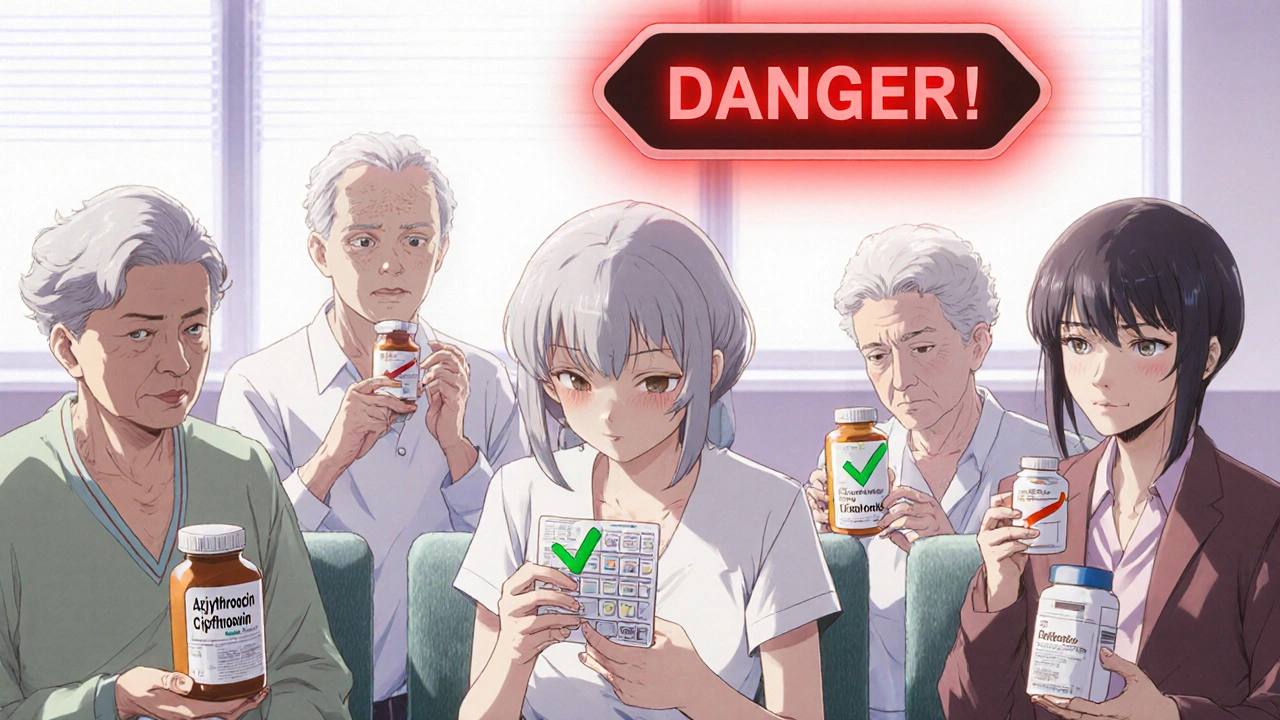Theophylline-Ciprofloxacin Dose Calculator
About This Tool
This calculator helps determine the appropriate theophylline dose adjustment when ciprofloxacin is prescribed. Ciprofloxacin significantly increases theophylline levels by 40-80%, which can be dangerous as theophylline has a narrow therapeutic window (10-20 mg/L).
Key Recommendations
When taking ciprofloxacin with theophylline:
- Reduce theophylline dose by 30-50% before starting ciprofloxacin
- Check theophylline blood level within 24-48 hours of starting ciprofloxacin
- Monitor for symptoms: nausea, rapid heartbeat, tremors, restlessness
- Consider safer antibiotics like levofloxacin (which has minimal interaction)
What Happens When You Take Ciprofloxacin With Theophylline?
Imagine you’re on theophylline to manage your COPD or asthma. It’s been working fine for years. Then you get a bad cough, your doctor prescribes ciprofloxacin, and within a few days, you feel nauseous, your heart races, and you start trembling. This isn’t just bad luck-it’s a known, dangerous interaction that’s been documented since the 1980s. Ciprofloxacin doesn’t just fight bacteria-it also shuts down your body’s ability to break down theophylline, causing toxic levels to build up in your blood. And unlike some drug interactions that are rare or theoretical, this one is real, predictable, and deadly.
The Science Behind the Danger
Theophylline is a powerful bronchodilator. It’s not a first-line drug anymore, but it’s still used in some patients with severe COPD or asthma because it works. But it’s also tricky. It has a very narrow window between helping and harming. The safe range is 10 to 20 mg/L. Go above 20 mg/L, and you risk side effects. At 25 mg/L, vomiting and rapid heartbeat become common. At 30 mg/L or higher, seizures and life-threatening heart rhythms can happen.
Ciprofloxacin is a fluoroquinolone antibiotic. It’s great for respiratory infections. But here’s the catch: it blocks an enzyme called CYP1A2. That’s the same enzyme your liver uses to clear theophylline from your body. When ciprofloxacin gets in the way, theophylline doesn’t get broken down. It just sits there, building up. Studies show ciprofloxacin can increase theophylline levels by 40% to 80%. That means if you were safely at 15 mg/L, you could jump to 27 mg/L in just a few days.
Who’s Most at Risk?
It’s not just anyone. Elderly patients are hit hardest. As we age, our liver slows down. Our kidneys slow down. We’re already clearing theophylline more slowly. Add ciprofloxacin, and the drop in clearance jumps to nearly 45%-much worse than the 35% seen in younger people. A 2015 meta-analysis confirmed this: patients over 65 need a bigger dose reduction just to stay safe.
People with existing heart conditions are also at higher risk. Theophylline toxicity can trigger arrhythmias, especially if you’re already on other meds that affect your heart rhythm. And those with liver disease? Even more vulnerable.
But here’s the scary part: it’s not just the elderly. A 2018 study found that over 12% of older adults on theophylline were still getting ciprofloxacin. That’s more than 1 in 8. And a 2021 study estimated that nearly 9,300 Medicare patients each year end up in the hospital because of this exact mix.

What Does the Evidence Say?
The data isn’t just theoretical. In 2011, researchers analyzed over 77,000 older adults in Ontario who were on theophylline. They found that those who took ciprofloxacin were almost twice as likely to be hospitalized for theophylline toxicity. The risk didn’t go up with other antibiotics like levofloxacin, amoxicillin, or trimethoprim-sulfamethoxazole. Only ciprofloxacin.
Even more telling: a 1990 case report in JAMA Internal Medicine described a 93-year-old woman with no history of seizures who had a grand mal seizure after starting ciprofloxacin. Her theophylline level was 32 mg/L. She recovered after stopping the antibiotic and lowering her dose. But not everyone is so lucky.
A 2020 review by the Institute for Safe Medication Practices rated this interaction as Category A: High Severity with Level 1: Probable Evidence. That’s the highest possible risk level. It’s not a ‘maybe.’ It’s a ‘definitely dangerous.’
What Should You Do?
If you’re on theophylline, here’s what you need to know:
- Avoid ciprofloxacin if possible. There are better choices. Amoxicillin-clavulanate, azithromycin, or doxycycline don’t interfere with theophylline. Ask your doctor if one of these will work for your infection.
- If ciprofloxacin is your only option, your theophylline dose must be cut by 30% to 50% before you start it. Don’t wait for symptoms. Don’t guess. Get your blood level checked right before you begin.
- Check your theophylline level every 24 to 48 hours after starting ciprofloxacin. Levels can spike fast. Waiting a week is too late.
- Know the warning signs. Nausea, vomiting, fast heartbeat, tremors, restlessness-these aren’t just side effects. They’re red flags. If you feel any of these, stop taking ciprofloxacin and call your doctor immediately.
What About Other Antibiotics?
Not all fluoroquinolones are the same. Levofloxacin and moxifloxacin have almost no effect on theophylline metabolism. Studies show levofloxacin raises theophylline levels by only 10% to 15%-not enough to be dangerous if your dose is already stable. If you need a fluoroquinolone, ask for one of these instead.
And it’s not just about antibiotics. Other drugs can also block CYP1A2. Cimetidine (Tagamet), fluvoxamine (an antidepressant), and even some herbal teas like St. John’s Wort can interfere. Always tell your pharmacist and doctor about everything you’re taking-prescription, over-the-counter, or supplement.

Why Do Doctors Still Prescribe This Combo?
It’s frustrating, but it still happens. A 2017 study found that nearly 70% of electronic alerts warning about this interaction were ignored by clinicians. Why? Two main reasons: they thought the infection was urgent, or they believed the patient had taken both before without problems. But past tolerance doesn’t mean future safety. Your body changes. Your liver function changes. Your other meds change. That one time you took both without issue? That doesn’t guarantee it’ll be safe now.
Also, ciprofloxacin is cheap and widely available. Some doctors default to it without checking for interactions. That’s changing, but slowly. The American College of Chest Physicians and the American Thoracic Society both say: avoid ciprofloxacin in patients on theophylline. But guidelines don’t always reach the bedside.
What’s Next?
Researchers are now looking at genetics. Some people have a variation in the CYP1A2 gene called *1F. If you have it, ciprofloxacin can reduce your theophylline clearance by 65%-way more than average. Clinical trials are underway to test if genetic testing could prevent these reactions before they start.
For now, the best protection is awareness. If you’re on theophylline, don’t take ciprofloxacin without talking to your doctor. And if you’re a caregiver for someone who is, make sure their meds are reviewed every time a new prescription comes in.
Bottom Line
This isn’t a rare side effect. It’s a well-known, preventable, and sometimes fatal interaction. Ciprofloxacin and theophylline shouldn’t be used together. Period. There are safer antibiotics. There are clear guidelines. And there’s more than enough evidence to prove it.
If you’re on theophylline, ask your doctor: ‘Is there a different antibiotic I can take?’ If they say no, insist on a blood test before starting ciprofloxacin. Your life depends on it.
Can I take ciprofloxacin if I’m on theophylline?
No, you should avoid ciprofloxacin if you’re taking theophylline. It blocks the enzyme your body needs to clear theophylline, causing dangerous levels to build up. This can lead to seizures, heart rhythm problems, or even death. Always ask your doctor for a safer antibiotic like amoxicillin-clavulanate, azithromycin, or levofloxacin.
What are the signs of theophylline toxicity?
Early signs include nausea, vomiting, tremors, rapid heartbeat, and restlessness. As levels rise, you may develop confusion, seizures, or irregular heart rhythms. If you’re on theophylline and start feeling any of these after taking a new antibiotic, stop the medication and seek medical help immediately.
How much should my theophylline dose be reduced?
When starting ciprofloxacin, reduce your theophylline dose by 30% to 50%. This should be done before or at the same time as starting the antibiotic. Always check your blood level before and during treatment. Never guess your dose-this interaction is too dangerous for trial and error.
Does levofloxacin interact with theophylline?
Levofloxacin has a very mild effect on theophylline, raising levels by only 10% to 15%. This is usually not dangerous if your dose is already stable. It’s considered a safer alternative to ciprofloxacin when a fluoroquinolone is needed. Still, monitoring your theophylline level is recommended.
How often should my theophylline level be checked?
If you must take ciprofloxacin with theophylline, check your blood level within 24 to 48 hours of starting the antibiotic. Levels can rise quickly. Check again after 72 hours and then weekly until the antibiotic is finished. Your doctor should order these tests-you shouldn’t have to ask.
Is this interaction more dangerous for older adults?
Yes. People over 65 clear theophylline more slowly to begin with. When ciprofloxacin is added, clearance drops by about 45%-much more than in younger people. That’s why older adults need a larger dose reduction and closer monitoring. This interaction is one of the leading causes of theophylline-related hospitalizations in seniors.

Comments (12)
Lugene Blair
October 29, 2025 AT 06:23
Yo, this post is a lifesaver. I had no idea cipro could wreck your theophylline levels like that. My dad’s on it for COPD, and his doctor just prescribed cipro last week. I’m calling his med team first thing tomorrow to push for azithromycin instead. Seriously, if you’re on theophylline, don’t let your doctor sweep this under the rug. This isn’t a ‘maybe’ - it’s a ‘you could die’ situation.
William Cuthbertson
October 30, 2025 AT 11:36
There’s something profoundly tragic about how medicine, despite its staggering advances, still clings to outdated habits like prescribing ciprofloxacin without checking for interactions. It speaks to a systemic failure - not of knowledge, but of attention. We have databases, alerts, and decades of peer-reviewed literature, yet the human element - the rushed physician, the overworked pharmacist, the patient who doesn’t speak up - remains the weak link. This interaction isn’t just pharmacological; it’s sociological. We’ve built a system that prioritizes speed over safety, and the elderly pay the price. The fact that 9,300 Medicare patients are hospitalized annually because of this is not a statistic - it’s a moral indictment.
Eben Neppie
October 31, 2025 AT 11:46
Let’s be crystal clear: ciprofloxacin + theophylline is a Class A, Level 1 interaction - the highest possible risk category. Any clinician who ignores this is either negligent or dangerously uninformed. The mechanism is well-established: CYP1A2 inhibition → reduced theophylline clearance → serum levels spike into toxic territory. Levofloxacin? Safe. Azithromycin? Safe. Doxycycline? Safe. There are zero valid clinical reasons to use cipro in this context. The 2011 Ontario study showing a near-doubling of hospitalizations? That’s not anecdotal - it’s epidemiological gospel. Stop rationalizing. Stop assuming ‘it was fine last time.’ Your liver doesn’t remember past tolerances - it only reacts to current enzyme blockade.
Hudson Owen
October 31, 2025 AT 15:57
I appreciate the thoroughness of this post. As a healthcare professional, I’ve seen too many cases where this interaction was overlooked. The guidelines are clear, the evidence is robust, and the consequences are severe. It is imperative that clinicians, pharmacists, and patients alike engage in proactive communication regarding polypharmacy. I encourage all patients on theophylline to maintain a current medication list and to request a medication review with their pharmacist whenever a new prescription is issued. Safety should never be left to chance.
Steven Shu
November 1, 2025 AT 23:54
This is why we need mandatory CYP1A2 screening before prescribing fluoroquinolones to anyone on theophylline. Why are we still playing Russian roulette with drug interactions? We’ve got the tools - genetic testing, EHR alerts, clinical decision support. If your system isn’t flagging this, it’s broken. Let’s stop treating this like an exception and start treating it like the emergency it is.
Anna S.
November 2, 2025 AT 02:39
Ugh, another ‘medical expert’ post. Can we just admit that Big Pharma pushes cipro because it’s cheap and profitable? They don’t care if old people die as long as the stock price stays up. And don’t even get me started on how doctors are too lazy to look up interactions - they just click ‘prescribe’ and walk away. This is capitalism in medicine. Wake up.
Yaseen Muhammad
November 4, 2025 AT 01:40
This is exactly the kind of post that should be shared with every pharmacy student and resident. I’ve seen this interaction cause ICU admissions in India too - often because cipro is the go-to antibiotic for ‘any infection.’ The lack of therapeutic drug monitoring in low-resource settings makes this even more dangerous. We need educational campaigns in primary care clinics. Knowledge isn’t power here - it’s survival.
Dylan Kane
November 4, 2025 AT 02:45
Okay but honestly, who even still uses theophylline? It’s like a 1970s relic. Why not just switch to a modern inhaler? This whole post feels like someone clinging to outdated meds while complaining about modern antibiotics. Maybe the real problem isn’t cipro - it’s that we’re using a drug that’s basically a time bomb.
KC Liu
November 6, 2025 AT 02:02
Let’s be real - this whole ‘dangerous interaction’ narrative is a distraction. The real threat? The FDA. They approved cipro in the 80s knowing full well about CYP1A2 inhibition. Why? Because they’re in bed with Bayer. And now they’re using ‘guidelines’ to make you feel safe while they quietly profit. You think your doctor is protecting you? Nah. He’s just following the script. Theophylline levels aren’t rising - your trust in the system is crashing.
Shanice Alethia
November 7, 2025 AT 04:58
I’M A NURSE AND I SAW A 78-YEAR-OLD WOMAN GO INTO SEIZURES BECAUSE OF THIS. SHE WAS ON CIPRO FOR A ‘COLD.’ HER KIDNEY FUNCTION WAS FINE. HER THEOPHYLLINE WAS ‘STABLE.’ SHE HAD NO HISTORY OF SEIZURES. SHE HAD A TRACHEOSTOMY. SHE DIDN’T MAKE IT. I’M STILL CRYING. NOBODY LISTENED. NOBODY CHECKED THE LEVELS. NOBODY ASKED ABOUT HER MEDS. THIS ISN’T A ‘WARNING.’ THIS IS A MURDER. AND IT HAPPENS EVERY WEEK.
Sam Tyler
November 8, 2025 AT 07:47
Thank you for sharing this. I’ve been managing my asthma with theophylline for over 20 years, and I’ve had multiple infections since then - never once was I warned about this interaction. I’m lucky I never had a reaction. But after reading this, I’m scheduling a med review with my pharmacist. I’ve already asked my PCP to switch me to an inhaler, but until then, I’m refusing any fluoroquinolone. This isn’t just about cipro - it’s about how rarely patients are educated about their own meds. We’re expected to trust, but not to question. That needs to change.
shridhar shanbhag
November 9, 2025 AT 14:21
As someone from India where cipro is sold over the counter, this is terrifying. People self-medicate for coughs and fevers - no prescription, no monitoring. I’ve seen patients come in with tremors and palpitations after taking cipro, and they had no idea they were on theophylline. We need public health campaigns - posters in pharmacies, radio ads, WhatsApp alerts. This isn’t just a clinical issue - it’s a public health emergency waiting to explode.